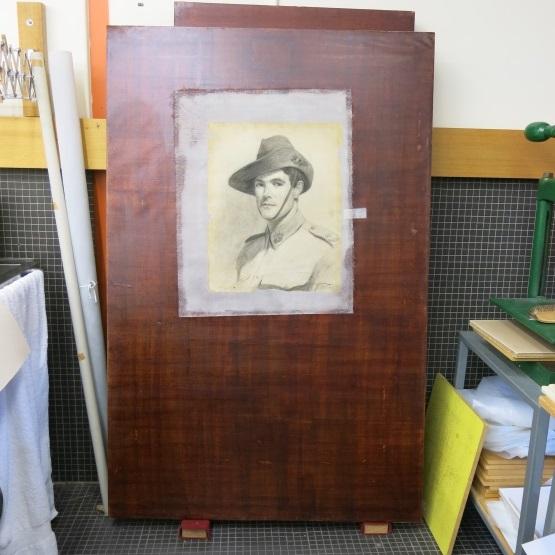Before and after: stories from the paper lab

Soldier from the Army Medical Corps (ART94358), before (left), during (centre) and after (right) the conservation process.
The Australian War Memorial has a huge collection of items on paper encompassing Australia’s wartime experience from the Boer War to the present day. Our collection includes artworks, photographs, and maps as well as official documents, personal diaries, and books.
The conservation of these important pieces of history is the job of our paper lab team. Their work involves assessing the item’s condition, and documenting, treating, and preparing works for exhibition and storage, ensuring that the collection is preserved for future generations.
The paper lab recently received a new acquisition, a drawing by an unknown artist titled “Soldier from the Army Medical Corps” (ART94358). The drawing was in fragile condition. A poor-quality window matt and backing mount board had left the paper support brittle and weak. The drawing also showed a history of previous restoration, staining, surface dirt, and surface distortion.
The lab’s first priority was to stabilise the work for storage and future display. They removed the acidic mount boards, exposing extensive damage to the paper underneath. Exposure to sunlight and other environmental conditions had left the paper discoloured.
After a dry surface clean, along with solubility and pH testing, the team washed the work in de-ionised water and added an alkaline buffer to reduce acidity. This process reduced the discolouration somewhat, but staining was still present. The work was given a light-bleach, placed in an alkaline bath in sunlight, after which it was washed again in de-ionised water.
The drawing was left to dry before the team went to work flattening and stabilising the paper. As it was quite weak they lined the back of the work with thin Japanese paper, employing a Japanese technique of tension drying using a Karibari board.
After lining with Japanese paper the work was adhered to the Karibari board, and allowed to dry slowly. Once dry it was removed gently with a bamboo spatula and the lining was trimmed to the edge of the work.
As a result of these treatments, the discolouration in the work was greatly reduced. The image became clearer, and its details sharper.
The flattening of the work removed the distortion on the surface and the lining stabilised the previous tears at the edges, providing added strength to the paper.
Before, during and after treatment

Conservator Gajendra Rawat removes the window matt.

Setting up the light-bleaching wash.

Drying the artwork on the Karibari board.

Removing the work from Karibari board.